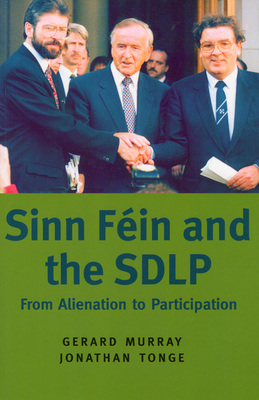Sinn Fein and the SDLP: from alienation to participation
John Corcoran reviews Sinn Fein and the SDLP: from alienation to participation by Gerard Murray and Jon Tonge, Hurst & Co., ISBN 1 85065 648 7, £14.95 pbk

THIS AUTHORITATIVELY researched book is a thought-provoking study of the peace process, which attempts to analyse how the Good Friday agreement fundamentally changed the political landscape of Ireland.
The main focus of the analysis is a comparison of the strategies employed by the SDLP and Sinn Féin, strategies, whose workings through, have, in recent years, seen a relative decline in the electoral fortunes of the SDLP and a growing ascendancy for Sinn Féin.
The book's research is remarkably well supported by the authors' surveys of grass-roots political activists, as well as interviews with leading political figures.
Gerard Murray and Jonathan Tonge are academics at Queen's University Belfast and the Centre for Irish Studies at the University of Salford respectively, they have divided up the book into their respective specialities, the SDLP, and the peace process.
This has led to a somewhat contrived division between the chapters, so that one chapter on the SDLP is followed by a chapter on the republican movement or the peace process; a pattern broadly repeated quite rigidly throughout the book. This limits, to some extent, the possibility for comparisons and contrasts within chapters.
More importantly, it artificially places the two political traditions into sealed compartments, reflecting organisational and political differences which may have been of primary importance to activists, but may well not have been as clear on the ground, as nationalist voters discussed issues and positions freely in homes, clubs, pubs and GAA grounds.
Therein lies the main analytic weakness of this book. It ponders the process so far, and the reader becomes aware that the key question for the authors is why the SDLP has not being more richly rewarded electorally for their role in the process, summed up in the concluding comment that " the verdict of nationalist voters may seem exceptionally harsh."
This approach minimises the extent to which nationalist voters may have perceived accurately that it has been the tenacity and single-mindedness, as well as the flexibility of the republican movement, which precipitated the very conditions for change.
Most nationalists of any shade (or indeed unionists and crypto-unionists in the 26 Counties) would concede that the Good Friday agreement could not have occurred without the driving force provided by the republican movement. This fundamental fact underlies both the efforts (whether in Dublin or Belfast) of the usual suspects to stultify the peace process, and the continued growth of Sinn Féin. Where exertions are expended towards the former, they are closely connected to attempts to stymie the latter.
Other factors alluded to in the authors' extensive research may also help to explain the recent electoral trends. In 2000, the average age of the SDLP membership was 57 and two thirds of the membership surveyed declared themselves as "inactive" within the party.
Listening to the SDLP's Eddie McGrady tentatively, almost apologetically, calling for the suspension of the PSNI officers involved in the recent fatal shooting of a young driver in Ballynahinch, constantly emphasising he was not wishing to "apportion undue blame", was in stark contrast to the vituperative bile he habitually reserves for republicans.
Perhaps it is within this telling cameo, and countless others like it through the years preceding it, that the answer to the central question posed in this informative and stimulating book lies, particularly the reasons behind the reduced credibility of the SDLP.
Connolly Association, c/o RMT, Unity House, 39 Chalton Street, London, NW1 1JD
Copyright © 2006 John Corcoran

